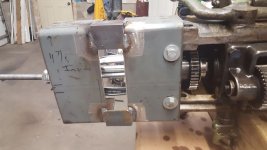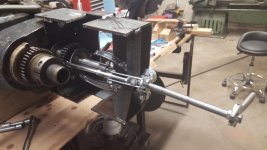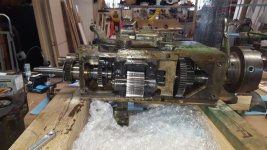ogesII
Aluminum
- Joined
- Nov 9, 2009
- Location
- Minnesota, USA
I dove into the single tooth clutch repair job today following the instructions from Carl in NH. Everything went well until I got the head stock on the bench and needed to remove the feed shaft to release the gear with the worn pin and the dog or clutch disc.
According to Carl's instructions I was expecting the gears to simply fall off the end of the shaft after I released the bearing OD from the housing. But that wasn't the case, the bearing seems to be pressed onto the shaft and I can't figure out how to get it off.
I fashioned a bracket to allow me to pull on the reverse feed clutch outside of the housing. The goal with the bracket is to remove the bearing from inside the housing and not the clutch disc I'm actually pulling on.


I haven't cranked on the gear puller yet because I really don't want to bend the reverse feed clutch that I'm pulling on. Does anyone have any thoughts on a) if this should be this difficult to pull off b) ideas on getting it off?
Here you can see the bearing is released from the OD already.

Thanks in advance! I thought this would be a one day project but I just spent half the day stuck on one bearing. I have some threading projects coming up and I'm excited to put her back together.
According to Carl's instructions I was expecting the gears to simply fall off the end of the shaft after I released the bearing OD from the housing. But that wasn't the case, the bearing seems to be pressed onto the shaft and I can't figure out how to get it off.
I fashioned a bracket to allow me to pull on the reverse feed clutch outside of the housing. The goal with the bracket is to remove the bearing from inside the housing and not the clutch disc I'm actually pulling on.


I haven't cranked on the gear puller yet because I really don't want to bend the reverse feed clutch that I'm pulling on. Does anyone have any thoughts on a) if this should be this difficult to pull off b) ideas on getting it off?
Here you can see the bearing is released from the OD already.

Thanks in advance! I thought this would be a one day project but I just spent half the day stuck on one bearing. I have some threading projects coming up and I'm excited to put her back together.




